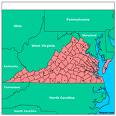Archive for August, 2009
A VIEW FROM THE OTHER SIDE OF THE BAR
“Hello, we’d like to do a tasting for two”.
 Thus begins a ritual, repeated hundreds of times a day, in wineries across the Old Dominion.
Thus begins a ritual, repeated hundreds of times a day, in wineries across the Old Dominion.
And it is a line I have heard, in various reiterations, more often than I can recall. For the last six years, I have worked behind the tasting bars of three Virginia wineries. It’s been great fun. I have amassed a slew of memories, and perhaps some sage advice for folks headed out for a day of winery hopping.
My adventure in the wine industry began a few years after my retirement in 2001. After a career with a federal agency, the last fifteen representing my employer on Capitol Hill, I was ready for a change in workplace environment and lifestyle. OK, I admit it; I also needed a source of income for my growing green fee expenses.
My first employment in the industry did not land me the coveted job of greeting and pouring wines for guests. I started at the bottom of the barrel—literally. Responding to an ad in a local paper, I was hired as a “Cellar Assistant” at a moderately large winery, producing some 7,000 cases a year. Shortly after an introduction to the art of scrubbing floors and cleaning the inside of stainless steel tanks and oak barrels, I learned the trade title of my job was actually, “Cellar Rat”. I could not have been prouder. If only my former colleagues could see me now.
The first year of learning the wine business, literally from the cellar up, was what hooked me on my beloved second career. Understanding the world of wine is to drink from a bottomless cup. Today, in the United States, some 55,000 different bottlings are available daily across the country. Accumulating even a passing knowledge of the varietals, production techniques, and countries of origin—just from the local grocery store shelves–can be daunting. And attempting an in-depth understanding of wines worldwide is a life long endeavor. Ah, but the research is so much fun.
 Perhaps the most interesting aspect of my job was my newfound interest in touring Virginia wineries. Visiting beautiful settings and tasting quality wines, added a rich dimension to my retirement years. My quest was on to learn as much as possible about our state’s wines and winemaking techniques, and sharing my discoveries with family and friends.
Perhaps the most interesting aspect of my job was my newfound interest in touring Virginia wineries. Visiting beautiful settings and tasting quality wines, added a rich dimension to my retirement years. My quest was on to learn as much as possible about our state’s wines and winemaking techniques, and sharing my discoveries with family and friends.
After nearly a year of seeing wine produced from a yeast’s eye view, I joined the staff of a winery closer to my home. Having earned my stripes in the cool cellar world of wine, I embraced the challenge of the tasting room. On my first day, I felt a bit rattled standing behind the bar and purporting to talk knowledgeably about the wines. I struggled to assure myself that I did, in fact, taste the honeysuckle and peach on the Viognier and the raspberry notes of the Cabernet Franc. I felt certain my guests would challenge me if I got a wine profile wrong. But, it did not take long to understand that the majority of wine lovers, both novice and educated, share some of this angst.
 Americans have not been raised to focus on flavors and aromas in their food and beverages. We eat and drink, and declare our experiences either good or bad. Nonetheless, unwrapping the mysteries in a glass of wine greatly enhances its enjoyment. When I realized this little secret, I was eager to share my revelation with as many folks as possible. The hallmark of a successful tasting room employee is knowledge, framed by enthusiasm. As you love, so will your guests love.
Americans have not been raised to focus on flavors and aromas in their food and beverages. We eat and drink, and declare our experiences either good or bad. Nonetheless, unwrapping the mysteries in a glass of wine greatly enhances its enjoyment. When I realized this little secret, I was eager to share my revelation with as many folks as possible. The hallmark of a successful tasting room employee is knowledge, framed by enthusiasm. As you love, so will your guests love.
I have gathered many wonderful stories from my years of wine pouring. Perhaps one of the more touching came from a white haired gentleman who slowly drove into our parking lot on a chilly March weekday, about three years ago. He sat alone in his car for a good five minutes as I watched from the window, not a soul at the bar. Finally, he made his way inside. During an hour of convivial conversation, his story unfolded. But, let’s have him share his tale.
“Me name is Bedford,” he said, as he stood at the bar, tentatively taking a sip of Viognier. “I come from a town in England called Bedford. My daughter gave me a book for Christmas last year, called the Bedford Boys. I have never traveled outside of England, but I have come to visit Bedford, Virginia.”
 “Really? And why?” I asked. It seems the old gentleman had vivid memories of World War II and the crucial role our GI s played in the liberation of Europe. During the D-Day invasion at Normandy, a Virginia village earned the heart crushing distinction of losing 21 of their young men, nineteen of the boys being killed within minutes of the beach landing. Today, a memorial to the fallen patriots is located in Bedford.
“Really? And why?” I asked. It seems the old gentleman had vivid memories of World War II and the crucial role our GI s played in the liberation of Europe. During the D-Day invasion at Normandy, a Virginia village earned the heart crushing distinction of losing 21 of their young men, nineteen of the boys being killed within minutes of the beach landing. Today, a memorial to the fallen patriots is located in Bedford.
This gentle Englishman had come to America to pay his respects to the town that had made the ultimate sacrifice. And his first stop, after leaving the airport, was to visit a Virginia winery. He did not fully understand what a tasting room was, but he was eager to learn more about a state that produced such valiant men. As he slowly drove away, I felt privileged to have been a small part of his journey of respect.
So, what might I offer, in the way of advice, to wine lover visiting a tasting room? First, don’t attempt to visit more than three wineries in a day. Relax. Take your time. Your understanding and appreciation of the wines will reveal themselves more fully, if you simply slow down. The old chestnut, “haste makes waste”, should become your three-word management plan for extracting maximum enjoyment from each winery you visit.
Take at least three or four cellar tours during the early months of your tasting odyssey. You will gain greater insight into how wine is produced, enriching your understanding of both the simplicity–and complexity–of winemaking. Availing yourself of free tours is an educational opportunity that will deepen your delight of the fruit of the vine.
 Make observations on tasting note sheets so as to learn which wineries you have enjoyed visiting. A simple file kept at home will refresh you on the wines you found most delightful. It can also lead to a compilation of your “Top Ten” favorite establishments.
Make observations on tasting note sheets so as to learn which wineries you have enjoyed visiting. A simple file kept at home will refresh you on the wines you found most delightful. It can also lead to a compilation of your “Top Ten” favorite establishments.
Another fun way to better understand Virginia wines is to drink them along side a bottle of the same varietal, from another state or country. Sound wasteful or over indulgent? Not at all. For instance, at home, open a bottle of Virginia Chardonnay and a bottle of California Chardonnay, and sip and compare both simultaneously. Then, use the rubber stopper and pump method to keep the remaining wines fresh for the next few days, and enjoy the experience over again. Comparing wines enhances your appreciation and knowledge of like varietals hailing from different wine producing regions.
Engage your fellow tasters during your tastings. Often, I have seen wonderful exchanges unfold as complete strangers begin a conversation about their mutual love of wine. And don’t be surprised if your newfound friends hail from distant states, or even overseas. Tasting room guests are drawn from points worldwide.
Ask questions freely. Your hosts will enjoy educating you in a variety of wine related subjects. And if they happen not to know the answer to a query, it should send them scurrying to get the information, and be ready the next time the subject comes up. I enjoy being stumped with a wine question. It presents an opportunity to grow my knowledge and be ready when the same question inevitably crops up.
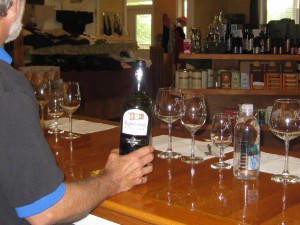 Finally, if you find your love of all things wine increasing, consider seeking a job behind the tasting bar yourself. Many wineries are looking for part-time employees, especially on weekends and holidays, when the crowds swell. You are typically offered generous discounts on wine purchases, and will be in the company of fellow enophiles. And the best part is the infectious camaraderie you will experience among both the guests and employees. It makes for a most enjoyable work environment.
Finally, if you find your love of all things wine increasing, consider seeking a job behind the tasting bar yourself. Many wineries are looking for part-time employees, especially on weekends and holidays, when the crowds swell. You are typically offered generous discounts on wine purchases, and will be in the company of fellow enophiles. And the best part is the infectious camaraderie you will experience among both the guests and employees. It makes for a most enjoyable work environment.
So it’s true. Life is, indeed, a party. And it’s being celebrated daily in tasting rooms across our state.
Published in the 2009 Harvest edition of the Virginia Wine Gazette.
It Helps to Have a Sheepskin When Converting Grapes into Serious Wine
Virginia is ranked fifth in wine production nationally, behind California, Washington, Oregon and New York.
More importantly, however, is the quality of wine emanating from our state. In the last ten years, Virginia has increasingly garnered national attention due to its rising wine superiority. Proprietors of our wineries have labored hard to improve their vineyard and cellar operations. What often began as a hobby or a very small business for many has grown into a thriving commercial industry. These rigorous efforts to increase quality are paying tasty dividends for Virginia wine lovers.
 But another emerging impetus for the rise in quality is the arrival—in increasing numbers—of professional winemakers. These are experienced experts whose careers are centered on the commercial production of fine wine. As in most endeavors, a quality education counts.
But another emerging impetus for the rise in quality is the arrival—in increasing numbers—of professional winemakers. These are experienced experts whose careers are centered on the commercial production of fine wine. As in most endeavors, a quality education counts.
The basic process of converting grapes into wine is simply a matter of letting yeast plunge into the fruit. After that, nature takes over. Yeast gormandize on the sugars in grape juice, creating carbon dioxide, alcohol and, of course, wine. Beyond that, keeping your environment clean would seemingly be the only steps in producing wine. Think again.
To take wine production to the level consumers expect today, a winemaker with a four-year degree in enology is a valued asset for any winery. Owners intent on achieving a reputation for consistent quality are increasingly handing the keys to their cellars over to these pros. This nascent movement is certain to further enhance Virginia’s wine reputation in the years ahead.
Just as you would expect your financial planning manager to possess a degree in finance or business, a growing number of wineries are hiring winemakers that have earned a Bachelor of Science in Enology and/or Viticulture.
 An enology degree, or the scientific study of winemaking, derives its name from the Greek words enos for wine, and logy for study. Viticulture is the study of grape growing and vineyard management. Together, these two disciplines combine to produce what is America’s fastest growing libation of choice.
An enology degree, or the scientific study of winemaking, derives its name from the Greek words enos for wine, and logy for study. Viticulture is the study of grape growing and vineyard management. Together, these two disciplines combine to produce what is America’s fastest growing libation of choice.
The surging national interest in wine is also providing career opportunities for enology graduates interested in pursuing a career associated with the finer things in life. From a strictly financial perspective, the occupation of professional winemaker offers substantial job security; especially if they land a job at a cellar producing more than 5,000 cases a year.
Many analysts think the wine industry is largely recession proof. During these difficult economic times, AC Nielsen reports that wine sales showed the greatest growth of any category over the previous year. The number of stores selling wine increased 24% in 2009 over 2008. Even box wines sales shot up 41% during the same period. It seems when times get tough, the enjoyment of wine is enhanced by the calming effect on ones nerves. Good news for winemakers.
In the United States, there are a limited number of colleges offering degrees in enology and viticulture. Among the oldest and finest are the University of California Davis and California State University, Fresno. Washington State University also has a degree program, as does Cornell University in New York. Understandably, Cornell’s focus is on wines grown in the cooler regions of the East Coast’s continental climate, while the California schools curriculum is centered on wines produced in its Mediterranean climes.
Our own Virginia Tech in Blacksburg does not offer a degree in enology or viticulture. Currently, there are not a sufficient number of potential candidates to support a separate degree program. But, the university provides the state’s wineries invaluable support through its Grape Chemistry Group. Dr. Bruce Zoeklein, an internationally known enologist and specialist in Virginia winemaking, heads the department and is widely credited with Virginia’s wine advancement in the last two decades.
While the romance of winemaking is undeniable, anyone considering a degree in enology or viticulture will quickly face the intellectual demands behind earning the sheepskin. Past strong academic performance is a valued asset. A four-year degree program involves intense and often-grueling work centered on chemistry, mathematics, statistics, biology and related sciences. It is not a degree to be pursued for those who pulled all nighters to pass chemistry 101.
 Over the course of four years, a student will drill deeply into the world of chemical analysis of fermentations, microbial control, yeast conversions, clonal impact, sensory evaluation, plant physiology & pathology, macroeconomics, genetics, winery management, marketing and more. Scholars must bring their A game to class each day.
Over the course of four years, a student will drill deeply into the world of chemical analysis of fermentations, microbial control, yeast conversions, clonal impact, sensory evaluation, plant physiology & pathology, macroeconomics, genetics, winery management, marketing and more. Scholars must bring their A game to class each day.
In addition to the rigorous classroom and lab work, students often perform internships. These off-campus assignments provide opportunities to apply their hard-earned book learning to the real world environment of a winery. This is where the rubber meets the road—or more appropriately–where the vine meets the wine. Producing wine, in a real time environment, rounds out the campus experience and puts the finishing polish on a student’s educational bona fides.
Once a person becomes a professional enologist, there often follows a self-elected tour aboard to gain further insight into the wide-range of winemaking styles. It is not uncommon for a professional winemaker to travel to France, Italy, Australia, Chile or other major winemaking nations to further burnish his or her credentials and gain a broader understanding of the art and science of winemaking.
Here in Virginia, we have winemakers not only with degrees earned in the United States but also France, Italy and South Africa. These vintners are attracted by the potential in Old Dominion wines. Wine talent often would rather advance professionally and become leaders in Virginia, rather than labor in obscurity in California or France among an army of enolgists.
In point, it is these individuals that are setting the stage for Virginia’s next leap to wine greatness. As the quality of our wines improve, pressure is increasingly brought to bear on all state wineries to excel. To stretch the point a bit, one might claim that in Darwin’s wine world of natural selection, it’s not monkeys that are evolving to a higher level but grape cultivation and winemaking.
 None of this discussion is meant to diminish the achievements of the self-taught winemakers who have placed Virginia on the national wine map. Their impressive accomplishments are evident with each bottle we open. Nevertheless, we are poised to have a growing cadre of professionally trained and talented artists further advance Virginia’s national wine reputation.
None of this discussion is meant to diminish the achievements of the self-taught winemakers who have placed Virginia on the national wine map. Their impressive accomplishments are evident with each bottle we open. Nevertheless, we are poised to have a growing cadre of professionally trained and talented artists further advance Virginia’s national wine reputation.
Published in the 2009 Harvest edition of the Virginia Wine Gazette.
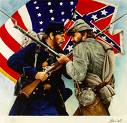 In 1862, as the tragedy of the American Civil War unfolded, an invasion of European vineyards began. In this instance, it was an army the United States had unwittingly launched against wine lovers. The resulting conflict came within a grape leaf of destroying wine worldwide.
In 1862, as the tragedy of the American Civil War unfolded, an invasion of European vineyards began. In this instance, it was an army the United States had unwittingly launched against wine lovers. The resulting conflict came within a grape leaf of destroying wine worldwide.
Could it happen again? Perhaps.
Our story begins in New York State where an amateur horticulturalist sent his friend, Monsieur Borty, a wine merchant in southern France, a case of native grapevines. This was an era of intense interest in Europe in importing novel and exotic plants from around the world. The Victorian scientific community was being swept up in the excitement of reproducing these plants for both scientific and commercial purposes. The advent of steamship travel meant that flora could be speedily shipped to the continent without fear of the cargo dying in transit.
Merchant Borty was quite pleased with his gift from America and promptly planted the vines in his small vineyard. Forebodingly though, within two years, vines in the surrounding southern Rhone Valley began to wither and die. Our Frenchman would go down in history as almost precipitating the demise of wine. Not a nice legacy.
So what was this invading horde and why were they so powerful? It was a tiny root-sucking aphid known as Phylloxera. And billions of them quickly began attacking the roots of the Vitis vinifera wine species, which produces ninety-nine percent of the world’s wine, then and now.
The success of the microscopic-size insect was due to the vulnerability of the European vines. Over eons, the little critter had been sucking on the roots of indigenous American grapevines with minimal damage. As is often the case in natural selection, our vines had slowly thrown up a defensive shield that protected them from destruction by the root muncher. In fact, smart parasites don’t often kill their hosts—it’s not beneficial for their kids’ future. Rather, the host adopts a way to live with its nemesis and the parasite doesn’t push the relationship to a breaking point.
When the aphid landed on French soil, however, it couldn’t resist the succulent—and defenseless—grape vines; so tasty were their roots it wouldn’t stop eating till it killed the host. And it killed with a vengeance. By 1890, vineyards throughout the wine-growing world were nearly wiped out. Wine growers panicked and employed every known and untried treatment to stop the wholesale slaughter of their vines. These actions ranged from the scientific approach of trying to find a natural enemy of the Phylloxera, to the ridiculous treatment of releasing schoolboys from their classes twice daily to urinate over the vines. Yep, they were that desperate.
A more horrific, but analogous, catastrophe occurred when Europeans landed in the Americas and infected the Indians with smallpox and other diseases. It is estimated tens of millions of Native Americans were killed by microbes for which they had no natural resistance.
While the French government offered huge financial rewards for anyone who could defeat the grape plague, for years no satisfactory solution was forthcoming. Then, in a bit of brilliant deduction, it occurred to some scientists that grafting their precious vines onto American rootstock might afford protection from the aphid. And it worked. Nonetheless, a great debate broke out between those pinning their hopes on a chemical based defeat of the pest and those who believed grafting was the answer.
A major obstacle to wide spread grafting was the inconceivable idea that the elite, delicate and delicious European vines would be joined at the hip, so to speak, with the rustic and inferior American vines. The general attitude was that decent wine could not be produced through such a marriage. Yet, the idea slowly took hold—-literally—and it was eventually acknowledged that wine equal to that made before the devastation could be created through grafting.
America had caused the blight, and in an ironic twist, had solved the crisis.
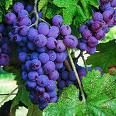 Today, almost all vines worldwide are grafted on to selected American rootstock to safely propagate the delicate Vitis vinifera grape. Only Chile and southern Australia are still growing wine grapes on original stock. In the case of Chile, it’s because the Andes mountain range on the east and the Pacific Ocean on the west, coupled with a loamy soil, have held the aphid at bay. In Australia, strict quarantine laws snatch the passports of any unwanted aphids considering a visit to their countryside.
Today, almost all vines worldwide are grafted on to selected American rootstock to safely propagate the delicate Vitis vinifera grape. Only Chile and southern Australia are still growing wine grapes on original stock. In the case of Chile, it’s because the Andes mountain range on the east and the Pacific Ocean on the west, coupled with a loamy soil, have held the aphid at bay. In Australia, strict quarantine laws snatch the passports of any unwanted aphids considering a visit to their countryside.
So does this success story ensure the permanent health of our beloved wine grapes? Not necessarily. No cure, other than grafting, has ever been found to eliminate the threat. One hundred and forty–seven years after the devastation in Europe began Phylloxera still lurks in vineyards. Time and evolution could see a resurgence of the dreaded pest.
One example of how such a scenario could again unfold occurred in the late 1980s in California. During the 1960s and ‘70s, the state’s surging wine industry had widely planted their grapes on a rootstock dubbed AXR#1—a hybrid cross between American and vinifera species. Experts had assured vineyard managers that it was totally resistant to the aphid’s attack. Slowly, however, in classic Darwinian fashion, one vineyard after another began to succumb to a new biotype of the pest. The resulting damage cost the industry millions of dollars to tear out the vines and replant with trusted resistant rootstock.
Today, no significant research is underway to examine the complicated issues of defeating Phylloxera permanently. Since resistant rootstock safely produces wine, the incentive to find a solution is not great. But, given the strong likelihood that the aphid is currently morphing into yet another, stronger vine pest, now would seem to be the time to devote resources to defeating the scourge.
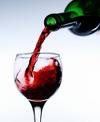 If the industry chooses not to act, could it mean the end of the classic varietals someday? That’s somewhat remote, but why even consider the possibility. After all, can you imagine enjoying a glass of musky scuppernong with your filet mignon? Neither can I.
If the industry chooses not to act, could it mean the end of the classic varietals someday? That’s somewhat remote, but why even consider the possibility. After all, can you imagine enjoying a glass of musky scuppernong with your filet mignon? Neither can I.
Published August 27, 2009 in the Culpeper Times.
GRAY GHOST VINEYARDS
2007 Reserve Chardonnay
$23
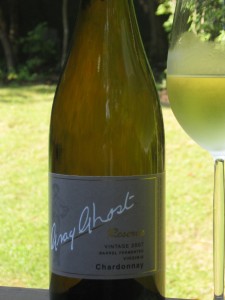 The Kellert Family has again produced a quality wine in its 2007 Reserve Chardonnay. The wine was fermented and aged in new French oak and underwent 100% malolatic fermentation, a vintner’s process that creates a silky mouth feel and buttery finish. On the palate, this well-balanced white displays pear, apple and spice notes and a rich, satisfying finish. The wine medalled fifteen times, including a gold at the 2009 Lodi International Wine Competition. Pair this beauty with shrimp and scallops in butter sauce. Drink now through 2011.
The Kellert Family has again produced a quality wine in its 2007 Reserve Chardonnay. The wine was fermented and aged in new French oak and underwent 100% malolatic fermentation, a vintner’s process that creates a silky mouth feel and buttery finish. On the palate, this well-balanced white displays pear, apple and spice notes and a rich, satisfying finish. The wine medalled fifteen times, including a gold at the 2009 Lodi International Wine Competition. Pair this beauty with shrimp and scallops in butter sauce. Drink now through 2011.
Gray Ghost Vineyards is located at 14706 Lee Highway, Amissville, VA 20106. The tasting room is opened March through December, Friday—Sunday from 11am to 5 pm; and during January and February on weekends 11am to 5 pm. (540) 937-4869.
On Saturday, August 8, the Hagarty Clan gathered to celebrate—nothing.
It’s late summer and the deck was calling so why not give the kids a call and see who’d be interested in a barbecue. “Did you say pulled pork, Dad?” Yep, they all showed up, sans our newly weds, who have not yet moved home from California.
 The day started off with two of my sons joining me at the South Wales golf course. We all apparently set a course record because the pro said he’d never seen three higher scores. Just kidding. We shot in the low eighties. If it gets any warmer, we don’t play. My oldest son avoided any links embarrassment by spending the day with his son and wife, who is expecting in a few months.
The day started off with two of my sons joining me at the South Wales golf course. We all apparently set a course record because the pro said he’d never seen three higher scores. Just kidding. We shot in the low eighties. If it gets any warmer, we don’t play. My oldest son avoided any links embarrassment by spending the day with his son and wife, who is expecting in a few months.
About 4 PM, the entire gang began arriving and the evening of merriment commenced. My wife Jean unveiled her new recipe for pulled pork, coupled with her legendary potato salad. Two of my daughters-in-law contributed a homemade three-bean casserole, white wine sangria and apple cake. My third daughter-in-law spent the day outfitting her family of four with back to school clothes and arrived ready for a glass of wine. Whoa. We remember those hectic shopping trips for kids’ clothes. There’s a special place in Heaven for Moms, for sure.
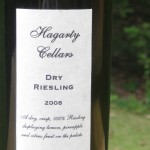 So what wine goes with pulled pork? Beer. At least that was the boys’ choice of libation and who’s to blame. It’s summer and a frosty bottle is hard to beat with barbecue. Jean and I, however, opted for a crisp, Hagarty Cellars Riesling. Not an obvious wine/food match but it underscores my number one wine rule. There are no rules. Fact is, I had a bottle of my Zinfandel at the ready but the evening was warm and the red wine urge never struck. My advice? Always go with your wine instincts on dining occasions. It’s fun and one never knows what happy matches are out there waiting to be discovered.
So what wine goes with pulled pork? Beer. At least that was the boys’ choice of libation and who’s to blame. It’s summer and a frosty bottle is hard to beat with barbecue. Jean and I, however, opted for a crisp, Hagarty Cellars Riesling. Not an obvious wine/food match but it underscores my number one wine rule. There are no rules. Fact is, I had a bottle of my Zinfandel at the ready but the evening was warm and the red wine urge never struck. My advice? Always go with your wine instincts on dining occasions. It’s fun and one never knows what happy matches are out there waiting to be discovered.
So what’s the recipe for pulled pork? I thought you’d never ask.
CROCKPOT PULLED PORK
Ingredients:
- Pork shoulder roast, about 4 pounds
- 2 medium onions, thinly sliced
- 1 ½ cups of water
- 1 bottle (16 ounces) barbecue sauce, or two cups of homemade sauce
- (Sweet Baby Ray’s Original Sauce is our favorite but the choice is yours)
- 1 cup chopped onion
Preparation:
Place half of the thinly sliced onions in the bottom of the crockpot; add pork and water, along with remaining onion slices. Cover and cook on LOW for 8 to 10 hours or 4 to 5 hours on HIGH heat setting. Drain liquid from slow cooker; chop the meat coarsely and discard excess fat. Put the pork back in the slow cooker. Add barbecue sauce and chopped onion. Cover and cook on LOW for 4 to 6 hours on longer. Stir occasionally. Serve warm with split buns and coleslaw.
Serves 8 to 10.
